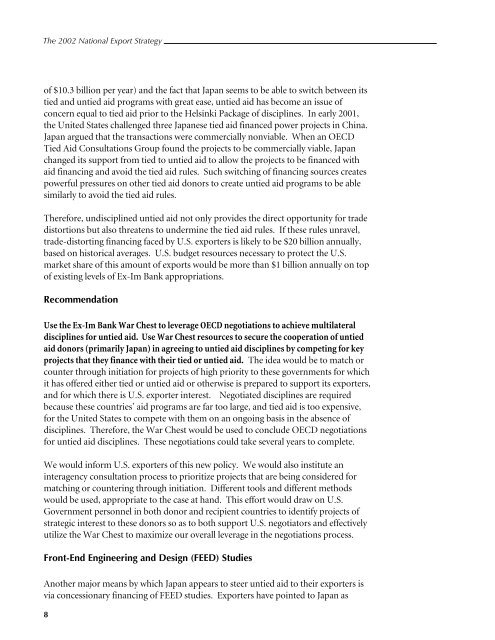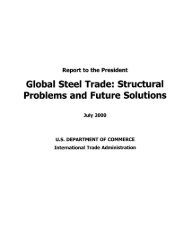National Export Strategy 2002 - International Trade Administration ...
National Export Strategy 2002 - International Trade Administration ...
National Export Strategy 2002 - International Trade Administration ...
Create successful ePaper yourself
Turn your PDF publications into a flip-book with our unique Google optimized e-Paper software.
The <strong>2002</strong> <strong>National</strong> <strong>Export</strong> <strong>Strategy</strong><br />
of $10.3 billion per year) and the fact that Japan seems to be able to switch between its<br />
tied and untied aid programs with great ease, untied aid has become an issue of<br />
concern equal to tied aid prior to the Helsinki Package of disciplines. In early 2001,<br />
the United States challenged three Japanese tied aid financed power projects in China.<br />
Japan argued that the transactions were commercially nonviable. When an OECD<br />
Tied Aid Consultations Group found the projects to be commercially viable, Japan<br />
changed its support from tied to untied aid to allow the projects to be financed with<br />
aid financing and avoid the tied aid rules. Such switching of financing sources creates<br />
powerful pressures on other tied aid donors to create untied aid programs to be able<br />
similarly to avoid the tied aid rules.<br />
Therefore, undisciplined untied aid not only provides the direct opportunity for trade<br />
distortions but also threatens to undermine the tied aid rules. If these rules unravel,<br />
trade-distorting financing faced by U.S. exporters is likely to be $20 billion annually,<br />
based on historical averages. U.S. budget resources necessary to protect the U.S.<br />
market share of this amount of exports would be more than $1 billion annually on top<br />
of existing levels of Ex-Im Bank appropriations.<br />
Recommendation<br />
Use the Ex-Im Bank War Chest to leverage OECD negotiations to achieve multilateral<br />
disciplines for untied aid. Use War Chest resources to secure the cooperation of untied<br />
aid donors (primarily Japan) in agreeing to untied aid disciplines by competing for key<br />
projects that they finance with their tied or untied aid. The idea would be to match or<br />
counter through initiation for projects of high priority to these governments for which<br />
it has offered either tied or untied aid or otherwise is prepared to support its exporters,<br />
and for which there is U.S. exporter interest. Negotiated disciplines are required<br />
because these countries’ aid programs are far too large, and tied aid is too expensive,<br />
for the United States to compete with them on an ongoing basis in the absence of<br />
disciplines. Therefore, the War Chest would be used to conclude OECD negotiations<br />
for untied aid disciplines. These negotiations could take several years to complete.<br />
We would inform U.S. exporters of this new policy. We would also institute an<br />
interagency consultation process to prioritize projects that are being considered for<br />
matching or countering through initiation. Different tools and different methods<br />
would be used, appropriate to the case at hand. This effort would draw on U.S.<br />
Government personnel in both donor and recipient countries to identify projects of<br />
strategic interest to these donors so as to both support U.S. negotiators and effectively<br />
utilize the War Chest to maximize our overall leverage in the negotiations process.<br />
Front-End Engineering and Design (FEED) Studies<br />
Another major means by which Japan appears to steer untied aid to their exporters is<br />
via concessionary financing of FEED studies. <strong>Export</strong>ers have pointed to Japan as<br />
8
















